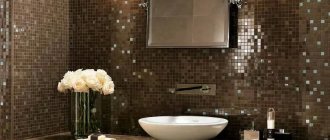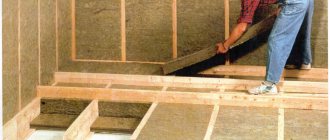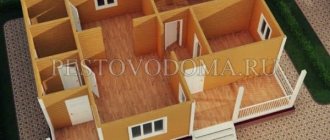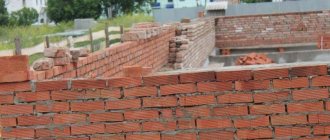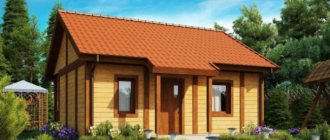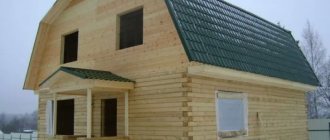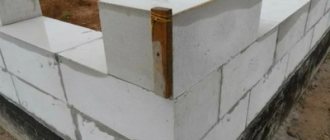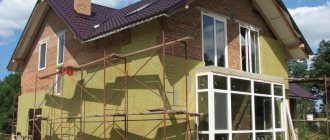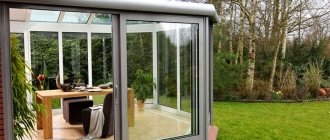Aerated concrete (gas silicate) is one of the most popular materials in modern house construction. Houses made of aerated concrete have become a familiar part of the countryside landscape; from 15 to 20% of new buildings built over the past 10 years are houses made of aerated concrete blocks. The porous structure of the material, characteristic of all lightweight concrete, ensures high performance characteristics of the structure. In many cases, owners decide to carry out additional insulation of the house using aerated concrete from the outside. This measure allows you to minimize heat loss and improve the microclimate of your home.
A house made of aerated concrete needs high-quality insulation Source makemone.ru
About the need for insulation
The structure of aerated concrete is a complex system of many open cells (voids) filled with air. This structural feature determines two useful properties of the material:
- Good thermal insulation . The manufacturer claims that the porous structure of aerated concrete brings its thermal insulation properties closer to wood, and is three to four times superior to brick. In the middle zone, according to SNiPs, the thickness of external walls of 400-500 mm will be sufficient without additional insulation if a block of a grade no lower than D500 is used. These calculations are correct, but do not take into account the second property of aerated concrete.
- Gas permeability . Open pores mean that the material is able not only to transmit, but also to accumulate moisture, which is what happens during the operation of the house. Walls that have absorbed a certain amount of moisture become denser (water accumulates in the pores, like in capillaries). The thermal conductivity of such walls increases, and the ability to retain heat decreases, which is especially noticeable in regions with harsh winters. And if in the south (where the winter temperature difference between inside and outside the building is small) country houses do not need insulation, then to the north the walls must be protected.
The properties of aerated concrete are determined by its structure Source pinterest.com
Let's look at some funny examples.
First example
Let us have a wall with an air gap. The gap is blank. The air in this gap has no connection with the air outside the gap. On one side of the wall it is warm, on the other it is cold. Ultimately, this means that the inner sides of our gap also differ in temperature in the same way. What happens in the gap? The air in the gap rises along the warm surface. When it's cold it goes down. Since this is the same air, a cycle is formed. During this cycle, heat is actively transferred from one surface to another. And actively. This means that it is strong. Question. Does our air gap perform a useful function? Looks like no. It looks like it is actively cooling the walls for us. Is there anything useful in this air gap of ours? No. There doesn't seem to be anything useful in it. Basically and forever and ever.
Second example.
Suppose we made holes at the top and bottom so that the air in the gap communicates with the outside world. What has changed for us? And the fact is that now there seems to be no cycle. Either it is there, but there is also air leaking and venting. Now the air is heated from the warm surface and, perhaps partially, flies out (warm), and cold air from the street takes its place from below. Is it good or bad? Is it very different from the first example? At first glance it gets even worse. The heat goes outside.
I will note the following. Yes, now we are heating the atmosphere, but in the first example we were heating the casing. How much is the first option worse or better than the second? You know, I think these are approximately the same options in terms of their harmfulness. My intuition tells me this, so, just in case, I don’t insist that I’m right. But in this second example we got one useful function. Now our gap has become an air ventilation gap, that is, we have added the function of removing moist air, and therefore drying the walls.
Is there convection in the ventilation gap or does the air move in one direction?
Of course have! In the same way, warm air moves up and cold air moves down. It's just not always the same air. And there is also harm from convection. Therefore, the ventilation gap, just like the air gap, does not need to be made wide. We don't need wind in the ventilation gap!
What's good about drying a wall?
Above, I called the process of heat transfer in the air gap active. By analogy, I will call the process of heat transfer inside the wall passive. Well, maybe this classification is not too strict, but the article is mine, and in it I have the right to such outrages. So here it is. A dry wall has a much lower thermal conductivity than a damp wall. As a result, heat will reach the harmful air gap more slowly from inside the warm room and will also be less carried outside. Simply, convection will slow down, since the left surface of our gap will no longer be so warm. The physics of the increase in thermal conductivity of a damp wall is that vapor molecules transfer more energy when colliding with each other and with air molecules than just air molecules colliding with each other.
Principles for choosing insulation
When choosing a suitable material for insulating aerated concrete walls, three factors are taken into account:
- Physical properties of the material . Aerated concrete can regulate the humidity in the room: the walls breathe, allowing water vapor to pass out. The external cladding should not impede this diffusion.
- Properties of insulation . It should not just be vapor permeable; vapor permeability should be higher than that of aerated concrete blocks.
- Insulation rule . It says: the vapor permeability of each subsequent layer of facade insulation should increase. If the selected material cannot easily allow air to pass out, then a ventilated gap must be installed behind it.
Compliance with these conditions helps to shift the dew point beyond the walls. If the masonry is not protected by anything, the moisture accumulating inside will inevitably freeze in severe frost. This leads to noticeable heat loss; after several cycles of freezing and thawing, the destruction of the surface layer of the blocks may begin.
Good to know! The dew point is a plane in the thickness of the wall where, due to the difference in external and internal temperatures, water vapor condenses into dew. With proper organization of external insulation, the dew point moves outward and cannot harm the walls.
Dew point shift when using insulation Source 1bcm.ru
The energy efficiency of a house is affected not only by correctly selected insulation, but also by the quality of wall masonry. If the interblock seams are made incorrectly (too thick), even high-quality insulation will not give the desired effect. Glue joints with a thickness of 1.5-2 mm are considered optimal. Laying blocks on cement-sand mortar with a seam of 10-12 mm will increase heat loss (and heating bills) by 20-20%.
Fixing the cladding
Regardless of the height of the house, a free-standing external wall half a brick thick is not able to withstand wind loads and seasonal deformations of the foundations due to ground vibrations.
To ensure that the cladding does not collapse and retains its decorative function in full, it is required to be anchored to the structural layer, the construction of which can be made of any material, including foam blocks, reinforced concrete or brick.
Anchoring should be understood as the fastening of two walls, the internal load-bearing and the external facing, to each other using metal rods of various designs, determined by the dimensions of the elements and the properties of the materials.
Selection and requirements for anchors
The following anchors are available:
- embedded, that is, installed in the seams of foam blocks or bricks during the construction of a building;
- implemented, used when the geometric dimensions of the elements of the structural and finishing layers do not match, or for the walls of a previously constructed house.
One end of the anchors, regardless of the type of part, has a wavy profile and is inserted into the cladding seam, and the second differs in geometry depending on the purpose, including:
- plate - used for adhesive seams;
- curved end - laid in full seams;
- spiral tip - used for driving in;
- screw profile - suitable for screwing into dowels.
- The acceptable material design is stainless steel, otherwise corrosion will destroy the parts before the cladding is destroyed. Too high a hardness is undesirable, since insufficient elasticity of the anchor can damage the surface of the facing brick.
- The anchor must be equipped with a polymer drip separator, which does not allow moisture to reach the surface of the heat-insulating layer and presses it close to the internal load-bearing wall, and also sets the minimum value of the ventilated gap at 20 mm.
- The diameter should not exceed 4 mm, and the increased wind load should be compensated by increasing the number of anchors, but not the cross-section.
- For embedded anchors, it is necessary to drill holes in the load-bearing wall of the house and drive plastic dowels into them, which differ in design: with a collar for driven in elements and without a collar for screwed-in elements, respectively.
Anchoring layout
Required number of anchors per 1 sq. a meter of load-bearing wall of a house is determined by the value of the wind load characteristic of a particular region of construction, and in the average version it is determined at the rate of 5 pieces per square meter. The fasteners are arranged in a checkerboard pattern with a fixed pitch:
- for the main wall - 0.5 m horizontally and 0.4 m vertically;
- in the area surrounding openings - 0.3 meters in both directions.
The distance of fastening points from the corners of the building, expansion joints and edges of openings should not be less than 150 mm and it is not advisable to retreat more than 250 mm.
Types and advantages of facade insulation
There is an alternative possibility - insulating the building from the inside. This option is less preferable for several reasons:
- Living space will decrease.
- effective ventilation system will need to be installed .
- There will be a high risk of mold formation , as the dew point will shift inside the home. Moisture and heat are optimal conditions for unpretentious microorganisms and fungi.
When else is a ventilation gap necessary?
In what other cases will you need a ventilation gap between the wall and the decorative covering:
- The material of the decorative layer promotes the formation of condensation.
- The wall material under the decorative layer can deteriorate from moisture (rot, cracks, etc.).
Let me give you a simple example. If you are planning to cover a wooden house with a metal profiled sheet, then you cannot do without a ventilation gap.
Otherwise, all the moisture that will condense on the inner surface of the corrugated sheet will be absorbed by the wooden walls, which will collapse as a result.
In the case of a ventilation gap, moisture, of course, condenses on the inner surface of the profiled sheet - this is metal. But it does not have direct contact with the surface of wooden walls. And the air current that is present in the ventilation gap carries away this moisture in the form of steam and removes it from the space between the decorative layer and the wall.
Consider which of the above cases is yours and choose whether you need a ventilation gap or not. Look at what kind of insulation you have, what wall material.
See more on this topic on our website:
- How to decorate a house from KBB? Question: Good afternoon, dear gentlemen! Please tell us how best to decorate the outside of a house made of expanded clay concrete blocks (CBB), what façade would be appropriate here, what materials can be used.
Insulating the walls of a wooden house from the outside with polystyrene foam Recently, people have begun to give preference to wooden houses. The first thing that attracts this natural material is its environmental friendliness. In addition to this, the wood is very good.
Sectional frame wall - diagram and comments This page shows a sectional frame wall along with insulation, which is mounted between the frame posts. Simply put, a frame wall in section looks like this.
Insulating the walls of a frame and wooden house with sawdust If you look at the history of the construction of residential buildings in cold regions, insulating walls with sawdust began to be practiced not so long ago. Sawdust as wall insulation during construction.
Construction of the walls of a frame house - pie diagram The simplest construction of the walls of a frame house is vertical posts connected by upper and lower frames and tied with jibs for additional structural rigidity. When using slab.
Video description
About mistakes when insulating aerated concrete in the following video:
Internal insulation reduces the usable area of housing Source makemone.ru
Considering different options for how to insulate a house made of aerated concrete from the outside, many opt for ordinary or mineral plaster; the latter is specifically designed for aerated concrete walls. The insulation layer can be sheathed with several finishing materials:
- Siding or clapboard .
- Face brick or decorative stone .
- Plaster.
- Grouting the joints followed by the use of vapor-permeable facade paint .
Installation of an insulating layer on the outside has the following positive aspects:
- The energy efficiency of the building increases and heating bills decrease.
- Load-bearing walls are not exposed to natural forces, which increases the service life of a country house.
- Along with improved sound insulation of walls, living comfort increases .
- The appearance of facade walls improves .
Scheme of a ventilated facade with finishing Source gettarget.ru
See also: Catalog of companies that specialize in insulating country houses.
Is the ventilation box a cold bridge?
The ventilation box cannot be a cold bridge. The ventilation box is mounted in the body of the facing brickwork and does not in any way disrupt the continuity of thermal insulation (the facing brickwork in multi-layer walls freezes and does not perform a heat-insulating function). As a rule, in three-layer or two-layer walls, where the facade is faced with facing or clinker bricks, the cold bridge is galvanized anchors or masonry mesh, acting as horizontal connections.
Video description
We will dwell in more detail on insulating a house with polystyrene foam. Find out how safe polystyrene foam is in our video:
Foam insulation Source beton-house.com
- Installation of foam plastic . It is placed in the spaces between the frame elements, additionally secured with foam or glue.
- Fixing the slabs . The foam sheathing is additionally reinforced with plastic dowels (metal dowels are not suitable, as they create cold bridges).
- Decorative finishing . A primer is applied to the foam layer, a fiberglass mesh is fixed on top, then reinforcing glue is applied. After the glue has dried, finishing is done with decorative or warm plaster.
See also: Catalog of projects of houses made of aerated concrete blocks presented at the exhibition “Low-Rise Country”.
Thermal insulation of brick walls with foam plastic
This technique is called a wet facade. The sequence of layers was described above. There are some peculiarities: it is important to wait for the glue to dry before proceeding with subsequent work. You need to fix the foam slabs from the bottom, moving up, one row at a time. The next row is done with a bandage so that the joints do not coincide.
After the brick walls are completely covered, it is important to immediately begin reinforcing the mesh by embedding the mesh in the adhesive solution. After all, if you leave polystyrene foam unprotected in the sun, it will begin to turn yellow and lose its properties. It’s also better not to delay with decorative finishing.
Important ! The gaps between the plates are filled with polyurethane foam, after which it is cut off.
Laying bricks with insulation will make the house warm, quiet and cozy. Heating costs are reduced several times. Having done everything correctly, there is no doubt that repairs will be required in a few years.
Insulation with mineral wool
Mineral wool is presented on the market in the form of slabs and rolls. It is actively used for insulating facade walls; basalt slabs are a special case of mineral wool, with similar qualities and performance characteristics. The widespread use of mineral wool is due to its many positive qualities:
- Good vapor permeable properties .
- High strength and immunity to biohazards. Materials are available in different hardness categories.
- Fire resistance (in case of fire it does not burn, but melts).
- Environmental friendliness . The basis of mineral wool is natural components that are not hazardous to human health.
Insulation with mineral wool Source no.decorexpro.com
Installation of mineral wool on the facade is carried out in the following order.
- Facade preparation . The wall is cleaned and leveled using cement mortar. Then the surface is primed and, if necessary, additionally leveled with vapor-permeable plaster.
- Frame installation . The guides of the frame structure are fixed taking into account the size of the material used (roll or rectangular mats). Thanks to the frame, a ventilation gap is formed, sufficient for air circulation along the wall and steam removal.
- Fastening mineral wool . It is carried out using glue applied to the slab material. Additional fixation is provided by plastic umbrella dowels.
- Preparing for finishing . The mineral wool layer is reinforced with mesh and glue.
- Finishing . The walls are coated with primer and plastered; The second common option is to cover it with putty and paint it. When finishing, do not use acrylic plaster, which has moisture-proof properties; such a coating will cause condensation to form.
Is a ventilation gap always necessary?
A question about house cladding is asked by Arkady Karpov, Moscow: Hello, I want to ask you a question.
Now a team is doing the sheathing of my house, insulating it and covering it with siding. After laying the film, siding is immediately sewn on top of it. I say – where is the gap? They say no need, we always do this. Are they doing the right thing and doing it the right way? Answered by Andrey Volokolamtsev, foreman of Avgust LLC, Podolsk.
Hello, Arkady. Perhaps what your builders are doing is not entirely correct, or perhaps it is not at all correct. So that you have a normal and systematic understanding of this issue, let’s first look at your case, and then see if a ventilation gap needs to be done and when.
So, let's figure out what material your house is made of. If the walls are made of vapor-permeable material, then if you use a decorative layer of siding, you must make a ventilated gap. Because moisture from the interior of your home in the form of steam will penetrate through the walls into the insulation and moisten it.
Insulation materials such as basalt wool do not like moisture very much. When they get wet by at least 15 percent, they already lose 50 percent in their thermal resistance.
There are, however, insulation materials that are not so susceptible to moisture and that do not lose their heat-insulating ability as much. This primarily applies to polyurethane foam, which can be sprayed onto the walls of a house.
Expanded polystyrene
Extruded polystyrene foam (EPS) is one of the types of foam plastic. Expanded polystyrene is produced by foaming the starting ingredients at high temperature and pressure. The production method determines the physical properties of the material - it is mechanically strong, frost-resistant and can have different densities. The higher the density (and strength) of EPS, the higher the thermal conductivity. Vapor and air permeability are always at the same (low) level, and water absorption is minimal. The combination of qualities makes it possible to widely use EPS as an insulating facade material.
An undesirable property of polystyrene foam for aerated concrete walls - low vapor permeability, leading to the appearance of a thermos effect and a shift in the dew point - is avoided by installing a ventilation gap. As in the case of using polystyrene foam, the second option is possible - installing powerful supply and exhaust ventilation. Installation of the insulating layer and decorative finishing is carried out according to the same scheme as for foam plastic.
Expanded polystyrene boards Source ko.decorexpro.com
How to reduce damage from air convection in the ventilation gap?
Obviously, to reduce convection means to prevent it. As we have already found out, we can prevent convection by colliding two convection currents. That is, make the ventilation gap very narrow. But we can also fill this gap with something that would not stop convection, but would significantly slow it down. What could it be?
Foam concrete or gas silicate? By the way, foam concrete and gas silicate are quite porous and I am ready to believe that there is weak convection in a block of these materials. On the other hand, our wall is high. It can be 3 or 7 meters or more in height. The greater the distance the air has to travel, the more porous the material we must have. Most likely, foam concrete and gas silicate are not suitable.
Moreover, wood, ceramic brick, and so on are not suitable.
Styrofoam? Not! Polystyrene foam is also not suitable. It is not too easily permeable to water vapor, especially if it needs to travel more than three meters.
Bulk materials? Like expanded clay? Here, by the way, is an interesting proposal. It could probably work, but expanded clay is too inconvenient to use. It gets dusty, wakes up and all that.
Low density wool? Yes. I think very low density wool is the leader for our purposes. But the cotton wool is not produced in a very thin layer. You can find canvases and slabs at least 5 cm thick.
As practice shows, all these arguments are good and useful only in theoretical terms. In real life, you can act much simpler and more prosaically, which I will write about in a pathetic way in the next section.
Polyurethane foam (PPU)
The material refers to sprayed substances; its application requires special equipment, which makes it not the most popular choice in private housing construction. After spraying, a homogeneous sealed layer with the following properties is formed on the wall:
- PPU penetrates the porous surface layer of the aerated concrete facade and forms a strong bond with it that does not collapse over time.
- The thermal conductivity of polyurethane foam, depending on density, is intermediate between polystyrene foam (minimum thermal conductivity coefficient) and mineral wool.
- The required thickness of polyurethane foam is determined by the type of material and ranges from 5 to 10 cm (in the middle band). The service life of such coating is at least 25 years.
- The vapor permeability of polyurethane foam after hardening is comparable to that of reinforced concrete; the filtration of air and water vapor completely stops. To remove water vapor accumulating in the premises, an effective ventilation system is organized.
The principle of creating a polyurethane foam layer Source stroyfora.ru
- If polyurethane foam (as well as polystyrene foam or EPS) is chosen as the external insulating layer, a finish is selected for the premises that does not allow steam to penetrate into the aerated concrete . Cement plaster and alkyd paints are suitable for this role; ceramic tiles and vinyl wallpaper are often used.
Difficulties
Considering the presence of unevenness in the surface of the supporting structure, the distance between it and the facing masonry without insulation usually exceeds the maximum permissible values and is 3-5 cm. And the problems of three-layer masonry are low air permeability and the accumulation of condensate inside the layers of the structure in the cold season, which limits the period service of the heat-insulating layer. But the main disadvantage is the impossibility of replacing it.
Feedback form
Your request has been sent successfully!
Thank you for your request! We will contact you shortly.
Methods of attaching insulation to the facade
In practice, three technologies are used to insulate external gas-block walls.
- Curtain façade . It is a wooden or metal frame structure, the pitch of which is equal to the width of the heat-insulating material. The insulation is placed in the cells of the frame, and a decorative layer is mounted on top.
- Wet facade . The aerated concrete surface is cleaned. The selected thermal insulation material is attached to the adhesive and additionally secured with dowels. Then the wall is plastered in 2 layers using a reinforcing mesh.
- Wet façade with reinforcement . If brick or natural stone is chosen as the finishing facing material, hooks are used to fix the insulation. Then the surface is reinforced with mesh and plastered. After the plaster has dried, cladding is carried out; The method allows you to do without strengthening the walls and foundation and in many cases is preferable.
What does a brick wall insulation pie consist of?
Before you insulate a brick wall at home yourself, you need to understand how to make an insulating pie. There are two options: wet facade and ventilated facade. The first is most often used for foam plastic, the second for mineral wool. The wet facade is done like this:
- Brick wall.
- Glue mixture.
- Thermal insulation layer (foam).
- Additionally, the insulation is fixed on dowels with umbrellas.
- Adhesive solution with reinforced mesh. The mesh is embedded in the adhesive layer so that it does not come into contact with the insulation.
- Primer, layer of plaster.
- Finishing decorative finishing: facing brick, decorative plaster.
As for the ventilated facade, the pie is like this:
- Brick wall.
- Lathing made of wood or metal.
- Vapor barrier.
- Insulation layer (mineral wool).
- Hydro-windproof film.
- Counter grille, thanks to which a ventilation gap is created.
- Finishing decorative layer (installation of siding, lining, decorative panels).
Cost of work on insulating the facade of an aerated concrete house
Construction organizations offer services for insulation and plastering of the facade of aerated concrete houses, the price of which is determined by several factors. The exact estimated cost of the work is determined during a direct inspection of the house. The cost of work is affected by the following parameters:
- Home inspection (the service is free in most cases if a contract is signed).
- Geometric features of walls, number of storeys and surface area.
- Consultation with a specialist on choosing optimal thermal insulation.
- Drawing up an .
- Purchase and delivery of materials.
- Carrying out work on insulation and finishing of the facade.
- Removal of construction waste .
How to properly veneer a house made of aerated concrete with bricks
If there are several options for structuring a wall pie, then the set of technological operations in one case or another will be different. It all depends on whether the cladding is carried out in parallel with the laying of the blocks, or whether the finishing is carried out later.
If the building is just under construction
In the process of new construction, both masonry can be erected simultaneously, along the entire thickness of the wall. In this case, the foundation is immediately poured to the required width; the upper edge of the base is necessarily waterproofed in two layers. Usually this is a roll of material glued to bitumen mastic.



